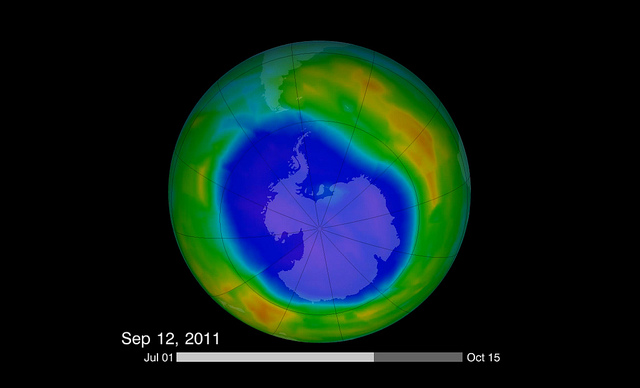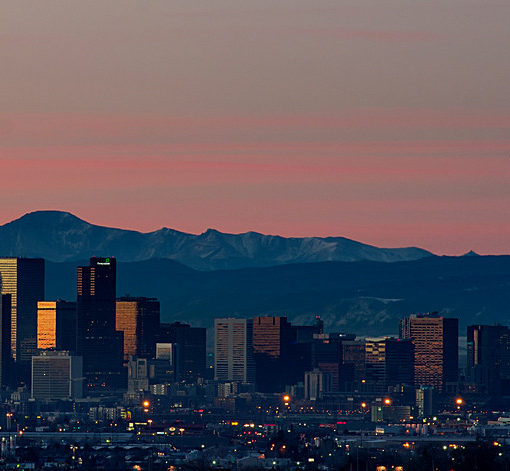Between the latest round of climate talks and the weather I’ve had a lot to think about. Over twenty years of international negotiations have yet to produce a binding climate treaty effective at reducing greenhouse gas emissions. The November US-China announcement looks helpful since cooperation and participation by both nations is essential for any serious plan, but the latest round of UN talks ended by asking everyone to set voluntary GHG limits. This has left me asking myself (again) what do we need for an effective climate treaty?
Between the unpromising climate talks and January’s ultra-cold temperatures I’ve been thinking lately of ultraviolet radiation. Sunshine, that is, not a UV lamp. For one thing, a little trip to the tropics for some warm air and sunshine would be just the thing to tamp down the winter blues. Thinking about climate and sunshine also has had me thinking about the Montreal Protocol that banned chlorofluorocarbons (CFC) and other ozone depleting substances (ODS), arguably the gold standard of international environmental treaties. Thanks to the success of this treaty, while sunscreen may be top of my packing list for a sunny destination, I don’t need to worry too much about developing skin cancer next year. So why was the world worried about CFCs and Ozone? How did so many nations come together to act so quickly? Are there any applicable lessons for negotiating a climate treaty?
The global concern over CFCs started with some chemistry (of course!). Many of you reading this probably know the basics of solar photochemistry and skin cancer.* The sun is pretty close to a black body radiator, pumping out energy across the E-M spectrum. The greatest output comes in the visible wavelengths (yay eyes!) with additional significant output in the ultraviolet region. This region of the spectrum is often subdivided into three sub-spectra: UV-A, from 320 to 400 nm, UV-B, from 290 to 320 nm, and UV-C, for wavelengths smaller than 290 nm. UV-B is great for converting 7-dehydrocholesterol to 1α,25-Dihydroxyvitamin D3, a particularly nifty vitamin, especially when it comes to beating the winter blues.
Unfortunately, UV-A and UV-B are also good at wrecking havoc with the DNA in your skin, often by causing the substitution of cytosine for thymine and by creating reactive species that can oxidize guanine and thymine to 8-hydroxyguanine and thymine glycol. Too much botched dermal-cell DNA is known to lead to melanoma in humans and other animals. While I have a special place in my heart for old Sol, skin cancer is bad news. I plan to avoid if at all possible. Hence my sunny winter getaway packing list starts with sunscreen. For smaller critters like marine plankton, the effects are lethal and have far-reaching impacts on marine food webs and global carbon and oxygen cycles.
Fortunately more than just biomolecules are good at absorbing ultraviolet radiation. Inorganics like triatomic oxygen – ozone – can also do a pretty bang up job. Thanks to particularly high stratospheric concentrations, we can count on ozone to absorb 95% to 99.9% of radiation across the UV spectrum before it gets to your skin. Better yet, there’s an ozone-oxygen cycle, the Chapman Cycle, at play in the atmosphere that works to keep the ozone concentrations high enough to continue protecting life on earth as we know it. In simplest form, molecular oxygen reacts relatively slowly after absorbing in the UV-C, and to a lesser extent UV-B, region producing a pair of oxygen atoms. A highly reactive species, atomic oxygen quickly reacts with molecular oxygen to form ozone. Ozone absorbs in the UV-A and UV-B regions and will slowly react to produce molecular oxygen plus atomic oxygen. This atomic oxygen can then quickly react with another oxygen molecule to reproduce ozone plus additional kinetic energy. Ozone is naturally removed by reacting with itself or atomic oxygen to form molecular oxygen, and by radicals, namely hydroxyl, nitric oxide, and atomic halides, through a number of catalytic cycles. Production of ozone can also be slowed when two oxygen atoms react to form molecular oxygen.
In equation form the Chapman Cycle may be represented as:
O2 + ℎν → 2 O
O + O2 → O3
O3 + ℎν → O2 + O
O + O2 → O3 + KE
O3 + O → 2 O2
2 O3 → 3 O2
X + O3 → XO + O2 Where X = ·OH, NO·, Cl·, Br·, O, etc
This natural cycle tends to keep stratospheric ozone levels quite stable and means I probably need just one bottle of sunscreen before heading out on my winter getaway. Anthropogenic activities can produce enough radicals, however, to siphon off significant amounts of ozone and upset the cycle. In June 1974, Rowland and Molina published an article in Nature suggesting that the widespread use of chlorofluorocarbons (CFCs) as refrigerants and propellants may be causing this to happen. UV photolysis of CFCs produced chloride radicals and abundant use of CFCs meant abundant production of chloride radicals that would be eating away at the ozone layer. Quick estimations suggested the resulting depletion looked could be significant enough to lead to increased rates of melanoma and disturbance of the earth’s oxygen cycle. As Rowland saw it, this meant that what was once a question “chiefly of scientific interest” revealed “a very significant global environmental problem.”
Addressing such a significant and global problem would require admixing more than a little law and policy into the chemistry and the law. Next month’s conclusion to this two-part article will explore some of the legal and policy factors that made the Montreal Protocol possible and successful, and how those may inform efforts to produce a climate treaty.
*And I’m sure some of you know the details much better than I – feel free to send corrections or amplifications.


